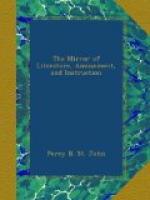gable of the same chamber near the door this device
to be painted,—“Ke ne dune ke ne
tine, ne prent ke desire;” and another runs thus,—“The
King, in presence of Master William the painter, a
monk of Westminster, lately at Winchester, contrived
and gave orders for a certain picture to be made at
Westminster in the wardrobe where he was accustomed
to wash his face, representing the King who was rescued
by his dogs from the seditions which were plotted
against that King by his subjects, respecting which
same picture the King addressed other letters to you
Edward of Westminster. And the King commands Philip
Lavel his treasurer, and the aforesaid Edward of Westminster,
to cause the same Master William to have his costs
and charges for painting the aforesaid picture without
delay; and when he shall know the cost, he will give
them a writ of liberate therefor.” For the
illustration of the elder historians, and as a means
of ascertaining how far narrations of events which
appear doubtful or improbable, are correct, these
and other buried documents possess great value.
That blackest charge against the memory of King John,
by which he is implicated in the murder of his nephew
Prince Arthur, has been brought forward in forms so
various, that common charity has induced many men to
withhold their credence from an accusation which rests
on vague and uncertain traditions. It is said,
however, that Arthur’s death, by whatever means
it was brought about, took place at Rouen; it has been
ascertained very lately for the first time, by inspection
of the attestations of records, that John was at that
place on that day; a circumstance not in itself enough
to lead men to a very violent suspicion of his guilt,
if the manner of the Prince’s death had not
been sudden and mysterious; but which, bringing the
charge at least somewhat nearer, may probably lead
to further discoveries. Of less importance, but
yet not without interest,—if it be interesting
to know accurately the early manners of a people,
and to trace their progress from periods when those
lights of science which are now beaming in full radiance
over the land, had just begun to glimmer above the
horizon,—is the following instance.
Matthew Paris relates, that in 1255, an elephant was
sent by the King of France to Henry III., and that
it being the first animal of that species that had
been seen in England, the people flocked in great
numbers to behold it. Upon the close rolls is
entered a writ tested at Westminster the 3rd of February,
39, H. III. (1255,) directing the sheriff of Kent to
“go in person to Dover, together with John Gouch,
the King’s servant, to arrange in what manner
the King’s elephant, which was at Whitsand,[12]
may best and most conveniently be brought over to these
parts, and to find for the same John a ship and other
things necessary to convey it; and if, by the advice
of the mariners and others, it could be brought to
London by water,” directing it to be so brought.
That the stranger arrived safely, is evident from




